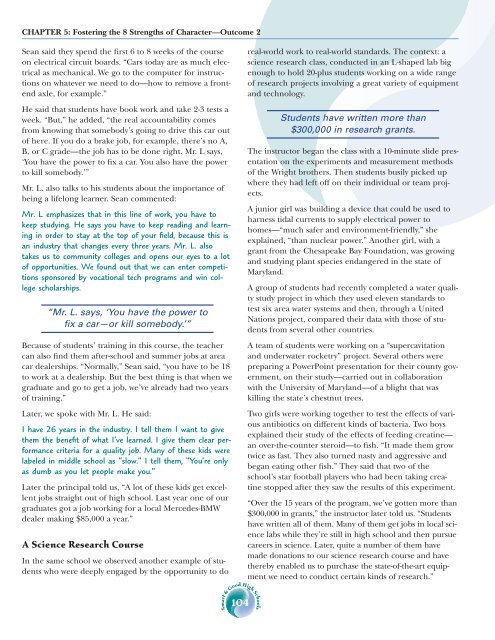Smart & Good High Schools - The Flippen Group
Smart & Good High Schools - The Flippen Group
Smart & Good High Schools - The Flippen Group
- No tags were found...
You also want an ePaper? Increase the reach of your titles
YUMPU automatically turns print PDFs into web optimized ePapers that Google loves.
CHAPTER 5: Fostering the 8 Strengths of Character—Outcome 2Sean said they spend the first 6 to 8 weeks of the courseon electrical circuit boards. “Cars today are as much electricalas mechanical. We go to the computer for instructionson whatever we need to do—how to remove a frontendaxle, for example.”He said that students have book work and take 2-3 tests aweek. “But,” he added, “the real accountability comesfrom knowing that somebody’s going to drive this car outof here. If you do a brake job, for example, there’s no A,B, or C grade—the job has to be done right. Mr. L says,‘You have the power to fix a car. You also have the powerto kill somebody.’”Mr. L. also talks to his students about the importance ofbeing a lifelong learner. Sean commented:Mr. L emphasizes that in this line of work, you have tokeep studying. He says you have to keep reading and learningin order to stay at the top of your field, because this isan industry that changes every three years. Mr. L. alsotakes us to community colleges and opens our eyes to a lotof opportunities. We found out that we can enter competitionssponsored by vocational tech programs and win collegescholarships.“Mr. L. says, ‘You have the power tofix a car—or kill somebody.’”Because of students’ training in this course, the teachercan also find them after-school and summer jobs at areacar dealerships. “Normally,” Sean said, “you have to be 18to work at a dealership. But the best thing is that when wegraduate and go to get a job, we’ve already had two yearsof training.”Later, we spoke with Mr. L. He said:I have 26 years in the industry. I tell them I want to givethem the benefit of what I’ve learned. I give them clear performancecriteria for a quality job. Many of these kids werelabeled in middle school as ”slow.” I tell them, “You’re onlyas dumb as you let people make you.”Later the principal told us, “A lot of these kids get excellentjobs straight out of high school. Last year one of ourgraduates got a job working for a local Mercedes-BMWdealer making $85,000 a year.”A Science Research CourseIn the same school we observed another example of studentswho were deeply engaged by the opportunity to doreal-world work to real-world standards. <strong>The</strong> context: ascience research class, conducted in an L-shaped lab bigenough to hold 20-plus students working on a wide rangeof research projects involving a great variety of equipmentand technology.Students have written more than$300,000 in research grants.<strong>The</strong> instructor began the class with a 10-minute slide presentationon the experiments and measurement methodsof the Wright brothers. <strong>The</strong>n students busily picked upwhere they had left off on their individual or team projects.A junior girl was building a device that could be used toharness tidal currents to supply electrical power tohomes—“much safer and environment-friendly,” sheexplained, “than nuclear power.” Another girl, with agrant from the Chesapeake Bay Foundation, was growingand studying plant species endangered in the state ofMaryland.A group of students had recently completed a water qualitystudy project in which they used eleven standards totest six area water systems and then, through a UnitedNations project, compared their data with those of studentsfrom several other countries.A team of students were working on a “supercavitationand underwater rocketry” project. Several others werepreparing a PowerPoint presentation for their county government,on their study—carried out in collaborationwith the University of Maryland—of a blight that waskilling the state’s chestnut trees.Two girls were working together to test the effects of variousantibiotics on different kinds of bacteria. Two boysexplained their study of the effects of feeding creatine—an over-the-counter steroid—to fish. “It made them growtwice as fast. <strong>The</strong>y also turned nasty and aggressive andbegan eating other fish.” <strong>The</strong>y said that two of theschool’s star football players who had been taking creatinestopped after they saw the results of this experiment.“Over the 15 years of the program, we’ve gotten more than$300,000 in grants,” the instructor later told us. “Studentshave written all of them. Many of them get jobs in local sciencelabs while they’re still in high school and then pursuecareers in science. Later, quite a number of them havemade donations to our science research course and havethereby enabled us to purchase the state-of-the-art equipmentwe need to conduct certain kinds of research.”104<strong>Smart</strong> & <strong>Good</strong> <strong>High</strong> <strong>Schools</strong>















